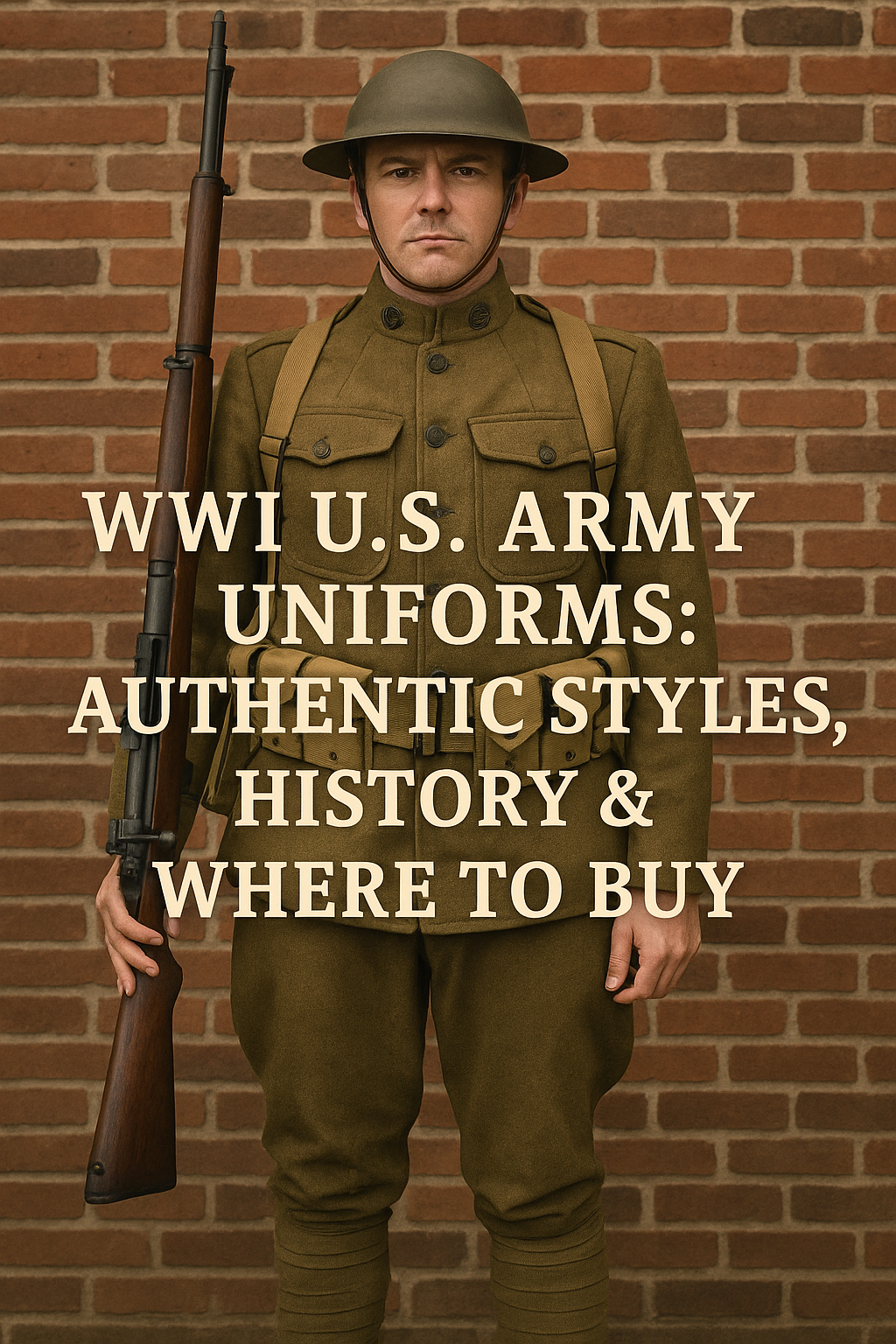
WWI U.S. Army Uniforms: Authentic Styles, History & Where to Buy
Published on Jun 19, 2025
A Complete Guide to WWI U.S. Army Uniforms
World War I marked a pivotal era in global history, and with it came significant changes in military gear — particularly the uniforms worn by U.S. Army soldiers. If you're looking to understand the WWI U.S. Army uniforms, whether for reenactments, collections, or educational purposes, this guide will walk you through everything from the uniform's origins to where you can find WW1 U.S. uniforms for sale today.
1. The Evolution of the WWI U.S. Army Uniform
When the United States entered World War I in 1917, its military forces were relatively unprepared in terms of uniform standardization. Early war uniforms were based on late 19th-century styles, but by mid-war, The U.S. military had adapted more practical, field-oriented designs inspired by European models.
Key Features of the WWI U.S. Army Uniform:
- Service Coat (M1917 Wool Tunic): Olive drab wool, with standing collar and five front buttons.
- Trousers: Wool breeches designed to tuck into puttees or leather leggings.
- Puttees: Wool strips wrapped around the lower leg for support and protection.
- Headgear: The iconic M1917 steel helmet (also known as the “Doughboy helmet”).
- Footwear: Hobnail boots designed for trench durability.
2. Uniform Components and Their Purpose
Each part of the uniform served both a functional and symbolic role.
- Olive Drab Wool Fabric: Blended functionality with camouflage, suited for European trench warfare.
- High-Collar Tunics: Offered neck protection but were later phased out for comfort.
- Puttees and Gaiters: Offered support in muddy, uneven trenches.
- Helmet Design: Modeled after the British Brodie helmet to protect from shrapnel.
3. Uniform Variations: Officers vs. Enlisted Men
- Officers' Uniforms: Featured finer wool, tailored fit, Sam Browne belts, and insignia indicating rank.
- Enlisted Men's Uniforms: More standard in design, mass-produced, and often heavier due to durable fabric.
Reproductions today often offer both styles, giving collectors and reenactors a range of options depending on the impression they wish to portray.
4. Reenactment and Collecting: The Rise in Popularity
The surge in interest in historical reenactment has increased demand for authentic WWI U.S. uniforms. Whether participating in living history events, creating educational content, or collecting for display, enthusiasts seek historically accurate pieces that mirror the original cuts, materials, and details.
Paddelaters.com offers a curated collection of World War One uniforms for sale, ensuring quality, accuracy, and affordability.
Connecting Past to Present: Related Uniform Styles
Understanding WWI uniforms also invites appreciation for related military attire used in other periods or for different environmental conditions.
WWII Tanker Uniform
Although from a later war, the Tanker Uniform WW2 shares similar utilitarian roots. Used by armored crews, these uniforms included:
- Jacket with insulation
- Bib overalls
- Helmet with padded liner
Available now on Paddelaters, these are perfect for collectors bridging WWI and WWII eras.
U.S. Army Hot Weather Uniform
Climate-specific uniforms became increasingly important. The US Army summer uniform offers a lightweight, breathable alternative for reenactments or events in hot conditions. Inspired by tropical campaigns, it’s great for those focusing on environmental authenticity.
German Soldier Costume
For a broader reenactment experience, pairing American uniforms with German soldier costumes helps tell the complete battlefield story. These costumes offer contrast and add realism to any WWI-themed event or display.
Tips for Buying Authentic WWI U.S. Army Uniforms
Here’s what to look for when shopping for a reproduction:
1. Historical Accuracy
- Match original patterns and cuts
- Correct wool weight and button types
- Proper insignia and patches (e.g., Division patches, rank)
2. Quality Materials
- 100% wool preferred
- Reenactment-grade vs display-grade options
- Authentic leather belts and boots
3. Sizing and Fit
- Many WWI soldiers were smaller by modern standards; reproductions usually adjust sizing.
- Double-check size charts before buying online.
At Paddelaters.com, each item is handpicked for accuracy and durability. Whether you’re building a full impression or starting with one piece, we’ve got you covered.
Why Choose Paddelaters for WWI and Military Uniforms?
- ✅ Wide selection of WWI U.S. uniforms and accessories
- ✅ Fast shipping for reenactments and events
- ✅ Expertly crafted reproductions
- ✅ Competitive prices and collector value
- ✅ Support for reenactors, educators, and hobbyists
Explore our collection of WW1 U.S. uniforms, WWII tanker uniforms, and U.S. Army summer gear all in one place.
Conclusion: Honoring History Through Authentic Uniforms
The WWI U.S. Army uniform is more than just fabric and stitching — it represents the bravery, innovation, and legacy of American soldiers during a pivotal time in history. Whether you’re commemorating the Great War, educating the next generation, or stepping into the boots of a Doughboy at your next reenactment, make sure your gear reflects the real thing.
